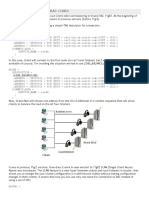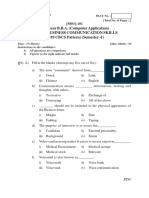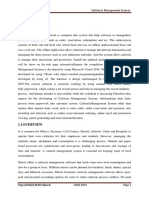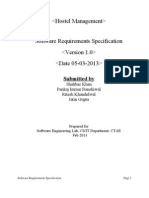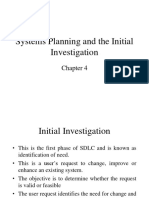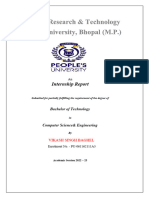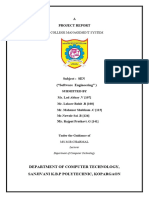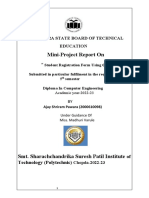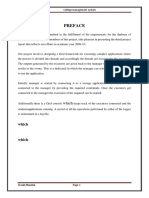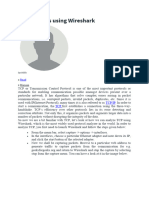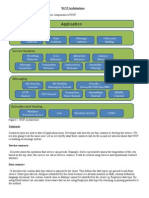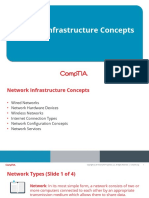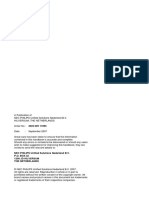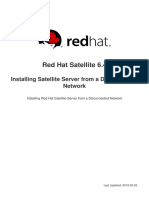College Management System Project Report
Uploaded by
peterbrightgeniusnyavorCollege Management System Project Report
Uploaded by
peterbrightgeniusnyavorlOMoARcPSD|20844436
College management system project
report
Computer Engineering (Savitribai Phule Pune University)
Downloaded by nyavor peter bright genius ([email protected])
lOMoARcPSD|20844436
Studocu is not sponsored or endorsed by any college or university
Downloaded by nyavor peter bright genius ([email protected])
lOMoARcPSD|20844436
A PRELIMENERY REPORT ON
“COLLEGE MANAGEMENT SYSTEM”
SUBMITTED TO THE SAVITRIBAI PHULE PUNE UNIVERSITY, PUNE
IN THE PARTIAL FULFILLMENT OF THE REQUIREMENTS
FOR THE AWARD OF THE DEGREE
OF
BACHELOR OF ENGINEERING (COMPUTER
ENGINEERING
SUBMITTED BY
STUDENT NAME: HARSHVARDHAN SHINGADE. (B2110) STUDENT NAME:
VIRAJ SHEDGE (B2110) STUDENT NAME: SUYOG BHISE (B2110) STUDENT
NAME: ABHINAY SALAVI (B2110)
DEPARTMENT OF COMPUTER ENGINEERING
Zeal College of Engineering & Research
NARHE, PUNE - 411041
SAVITRIBAI PHULE PUNE UNIVERSITY
2020 -2021
[P-2]
Downloaded by nyavor peter bright genius ([email protected])
lOMoARcPSD|20844436
CERTIFICATE
This is to certify that the project report entitles
“COLLEGE MANAGEMENT SYSTEM”
Submitted by
STUDENT NAME: HARSHVARDHAN SHINGADE. ()
VIRAJ SHEDGE ()
SUYOG BHISE ()
ABHINAY SALAVI ()
is a bonafide student of this institute and the work has been carried out by him/her under the
supervision of Prof.Balaji and it is approved for the partial fulfillment of the requirement of
Savitribai Phule Pune University, for the award of the degree of Bachelor of Engineering
(Computer Engineering).
Prof. Balaji Prof. A.V. Mote
Guide Head
Department of Computer Engineering Department of Computer Engineering
(Prof. ________________) (Dr.Ajit M. Kate)
External Examiner Principal,
SPPU Zeal College of Engineering & Research,
Pune41
Place: Pune
Date:
ACKNOWLEDGEMENT
We had a great experience working on this project and we got to learn a
plethora of new skills through this project. However, it would not have been
possible without the kind support and help of many individuals. We would like to
extend our sincere thanks to all of them.
We are highly indebted to the teachers and especially Prof. Balaji for their guidance
and constant supervision as well as providing necessary information regarding the project and
also for their support in completing the project
Downloaded by nyavor peter bright genius ([email protected])
lOMoARcPSD|20844436
HARSHVARDHAN SHINGADE. () VIRAJ SHEDGE
() SUYOG BHISE ()
ABHINAY SALAVI ()
ABSTRACT
We have immense pleasure in presenting the report for our project entitled
“College Management System”. We would like to take this opportunity to express our
gratitude to a number of people who have been sources of help & encouragement during the
course of this project.
We are very grateful and indebted to our project guide Mr. Balaji & our respected
HOD Prof. A.V. Mote for providing their enduring patience, guidance & invaluable
suggestions. They were the one who never let our morale down & always supported us
through our thick & thin. They were the constant source of inspiration for us & took utmost
interest in our project.
We would also like to thank all the staff members for their invaluable co-operation &
permitting us to work in the computer lab. We are also thankful to all the students for giving
us their useful advice & immense co-operation. Their support made the working of this
project very pleasant.
TABLE OF CONTENTS
Page No.
LIST OF ABBREVATIONS i 01 Introduction 1 1.1
LIST OF FIGURES ii Motivation 2
LIST Problem
1.2 OF Definition
TABLES iii 3
Sr.No. Title of Chapter 02 Literature Survey 4
03 Software Requirements
Specification 5
3.1 Introduction 5
3.1.1 Project Scope 5
3.1.2 User classes and characteristics 5
3.1.3 Assumptions and Dependencies 6
3.2 Functional requirements 7
3.2.1 End users 7
3.2.2 Developers 8
3.2.3 Authority level 1 9
Downloaded by nyavor peter bright genius ([email protected])
lOMoARcPSD|20844436
3.2.4 Authority level 2 10
3.3 External Interface Requirements 11
3.3.1 Hardware interfaces 11
3.3.2 Software interfaces 11
3.3.3 Communication interfaces 11
3.4 Nonfunctional requirements 11
3.4.1 Performance requirements 11
3.4.2 Safety requirements 11 3.4.3 Security requirements 12
3.4.4 Software quality attributes 12
3.5 System requirements 14
3.5.1 Database requirements 14
3.5.2 Software requirements 14
3.5.3 Hardware requirements 14
3.6 Analysis models: SDLC model to be applied 15
3.7 System implementation plan 16
04 System Design 18
4.1 System Architecture 18
4.2 Data flow diagram 19
4.3 Entity relation diagram 20
4.4 UML diagram 21
05 Other Specification 22
5.1 Advantages 22
5.2 Limitations 22
4.2 Data Flow Diagrams
4.3 Entity Relationship Diagrams
4.4 UML Diagrams
05 Other Specification
5.1 Advantages
5.2 Limitations
5.3 Applications
06 Conclusions & Future Work
Appendix A: Problem statement feasibility assessment using, satisfiability analysis and NP
Hard, NP-Complete or P type using modern algebra and relevant mathematical models.
Appendix B: Details of the papers referred in IEEE format (given earlier) Summary of the
above paper in not more than 3-4 lines. Here you should write the seed idea of the papers you
had referred for preparation of this project report in the following format.
Example:
Thomas Noltey, Hans Hanssony, Lucia Lo Belloz,” Communication Buses for Automotive
Applications” In Proceedings of the 3rd Information Survivability Workshop (ISW-2007),
Boston, Massachusetts, USA, October 2007. IEEE Computer Society.
Appendix C: Plagiarism Report
Downloaded by nyavor peter bright genius ([email protected])
lOMoARcPSD|20844436
LIST OF ABBREVATIONS
ABBREVIATION ILLUSTRATION
VPN Virtual Private Network IP
Internet Protocol
IDS Intrusion Detection System
TCP Transmission Control Protocol
Downloaded by nyavor peter bright genius ([email protected])
lOMoARcPSD|20844436
LIST OF FIGURES
FIGURE ILLUSTRATION PAGE NO.
1.1 System Design 3
1.2 Waterfall model 5
2.1 DFD level 0 11
3.1 DFD level 1 12
Downloaded by nyavor peter bright genius ([email protected])
lOMoARcPSD|20844436
LIST OF TABLES
TABLE ILLUSTRATION PAGE NO.
4.1 Project Plan 29
3.1 Packet Information 47
3.2 Network Error 48
3.3 IP Configuration 48
Downloaded by nyavor peter bright genius ([email protected])
lOMoARcPSD|20844436
Introduction
For accomplishing big projects, the number of developers work collectively on
different modules. Their efforts when combined together gives the final outcome.
However, a member working on one module may encounter the need to understand other
modules. Hence, he may feel the need of telling the concerned member to explain his
module. It may be time consuming and troublesome for the concerned member to explain
the entire code of the module. Therefore, there arises a need for a tool like CLASS
BROWSER which gives the class diagram of the entire module(project). It is quite
reliable and easy to understand. It also helps in debugging large projects.
The traditional view of software development takes an algorithmic
perspective. In this approach, the main building block of all software is the procedure or
function. This view leads developers to focus on issues of control and the decomposition
of larger algorithms into smaller ones. There is nothing inherently evil about such a point
of view except that it tends to yield brittle systems. As requirements change and the
system grows, systems built on algorithmic focus turn out to be very hard to maintain.
The contemporary view of software development takes an object-
oriented perspective. In this approach, the main building block of all software systems is
the object or class. Simply put, an object is a thing, generally drawn from the vocabulary
of the problem space or the solution space; a class is a description of a set of common
objects. Every object has identity, state, and behavior.
Motivation
• The software facilitates the administrators to know the present status
of a student of the college.
• The software gives the information such as student personal data,
student fees details, results etc.
• Generating the print reports of student personal, fee as well as result
details….
• Hence, we conclude that the present system (CMS for Colleges)
would definitely help the user by saving time and effort by reducing the
processing time and volume of errors.
• The efficiency of the work done would be improved and work
satisfaction on the part of the employees after computerization would
Downloaded by nyavor peter bright genius ([email protected])
lOMoARcPSD|20844436
definitely on high. The customer satisfaction would be definitely higher
when compared to the old manual system
Downloaded by nyavor peter bright genius ([email protected])
lOMoARcPSD|20844436
Problem Definition
• The existing system which we using in our college is traditional
process is a complete manual process.
• Now-a-days, education is playing very significant role in the society.
Day-by-day, the percentage of illiterates are decreasing and the
percentage of literates is increasing.
• Education will change the society in all the aspects and everyone
wants to study higher professional degrees.
• Admissions are increasing day by day so there by ratio of
establishment new colleges and schools are also increasing.
• But the actual challenge is starting from now. Most of the schools and
colleges are maintain student information in records.
• When the number of records increased, it is difficult to maintain the
information of each student in the old manual system.
• Maintaining the records manually leads to error prone and required
more man power and it consumes more time for processing the
records.
Downloaded by nyavor peter bright genius ([email protected])
lOMoARcPSD|20844436
Literature Survey
Title Publication & Objective
Sr Year
no
.
1. A Research International To monitor Paper on Journal of
attendance for the College Computer college students.
Management Applications Students as well as
System. (0975 – 8887) staffs logging in
- July 2015 may also access or
can be search any of
the information
regarding college.
2. Smart International To provide a simple College
Journal of interface for the
Management Engineering maintenance of
System Research & student
Technology information. It can
(IJERT) - 2019 be used by
educational institutes
or colleges to
maintain the records
of students easily.
3. SOFTWARE REQUIREMENTS SPECIFICATION
3.1 INTRODUCTION
3.1.1 Project Scope
The benefits of college management system for the employee are they can create
any kind of certificate easily using this system. They can easily retrieve all information
related to student and faculty. Admin has all the Collective records of students as well as
faculty of all the branches. Admin can check all the records of faculty of all departments
anytime. This system gives easy approach to find the detail information for any
student/faculty. Using this college management system, it is very easy to
handle all functionality of college. This system is beneficial for both students and faculty
as they can get all previous or current information when they need. This system is also
Downloaded by nyavor peter bright genius ([email protected])
lOMoARcPSD|20844436
helpful to maintain the students record like admission record, fees record, exam result
records. College management system can help to get all or a particular student attendance
information. Also, it can help to maintain the fees and accounting reports of college in
proper way. This system also helps to generate mark sheets of current year.
3.1.2 User Classes and Characteristics
In our system user can be classified as below:
1.End user:
The end users of the project are students and faculty. Students
who are looking for data like notes and notices, and faculty who are assigning
them the work as well as provide them notes.
2.Developers:
The developers are those who look towards the system, maintain it, find
bugs and fixes it.
3.Authority level 1:
The authority level has right to give to give access or revoke the
access of the system if any wrong malicious activities found from the user.
4.Authority level 2:
All the functions of Authority 1 are extended to Authority 2. In
addition to it has access to check current user status and account details.
Downloaded by nyavor peter bright genius ([email protected])
lOMoARcPSD|20844436
3.2FUNCTIONAL REQUIREMENTS
3.2.1End Users
Functional Requirement Number
Function Requirement Specification
EU1 User should be able to login to the system
EU2 User should be able to view all the information
EU3 User should be able to insert student details
EU4 User should be able to manage students/faculty
details
EU5 User should be able to change their password
EU6 User should be able to manage students detail
EU7 User should be able to manage faculty details
EU8 User should be able to update and edit a data
EU9 User should be able to delete their own data
EU10 User should be able to change Username
Downloaded by nyavor peter bright genius ([email protected])
lOMoARcPSD|20844436
3.2.2Developers
Functional RequirementFunction Requirement Specification
Number
D1 Developersshould be able to login to the system
D2 Developersshould be able to change their password
D3 Developersshould be able manage students/faculty data
D4
Developersshould be able to Maintain the system
Developersshould be able to find bugs in system
D5
D6
Developersshould be able to fix the bugs in system
Developersshould be able to update the password of a user
D7
Downloaded by nyavor peter bright genius ([email protected])
lOMoARcPSD|20844436
3.2.3Authority Level
1
Functional RequirementFunction Requirement Specification
Number
AL1-1 Authority Level 1 should be able to login to the system
AL1-2 Authority Level 1 should be able to change their password
AL1-3 Authority Level 1 should be able to view all information
Authority Level 1 should be able to give access to the user
AL1-4
Authority Level 1 should be able revoke the access of the
AL1-5
system
From the user
Authority Level 1 should be able to Manage students
AL1-6 details
Authority Level 1 should be able to manage faculty
AL1-7
details
Authority Level 1 should be able to update the password
AL1-8
of a user
3.2.4 Authority Level 2
Downloaded by nyavor peter bright genius ([email protected])
lOMoARcPSD|20844436
Function Requirement Specification
Functional Requirement
Number
AL2-1 Authority Level 2 should be able to login to the system
AL2-2 Authority Level 2 should be able to change their password
AL2-3 Authority Level 2 should be able to view all the information
AL2-4 Authority Level 2 should be able to give access to user
AL2-5 Authority Level 2 should be able to revoke access from user
AL2-6 Authority Level 2 should be able to manage students detail
AL2-7 Authority Level 2 should be able to manage faculty details
AL2-8 Authority Level 2 should be able mange system admin
AL2-9 Authority Level 2 should be able to update the password of a
user
Authority Level 2 should be able to manage role of the user
AL2-10
Authority Level 2 should be able to manage user permission
AL2-11
Authority Level 2 should be able to manage students profile
AL2-12
Authority Level 2 should be able to check current
AL2-13
student/faculty status
and their details
3.3 EXTERNAL INTERFACE REQUIREMENTS
3.3.1 Hardware Interfaces
• A PC
• Android Mobile
3.3.2 Software Interfaces
• Windows 7 and above/ Mac OS 10 and above / Linux
• Any Latest web browser
Downloaded by nyavor peter bright genius ([email protected])
lOMoARcPSD|20844436
3.3.3 Communication interfaces
• Internet connection if deployed remote.
• Local Area Network if deployed on site only
3.4 NONFUNCTIONAL REQUIREMENTS
3.4.1 Performance Requirements
• For user, it does not require a powerful processor or
graphics card, much ram or disk space and can run
smoothly.
• It requires a system with a minimum 4 GB ram and a
multi core processor, so that its performance is not
hampered and slowed down.
• User should know the basic Internet concept
• User should be aware of the web services
• User should be aware of the search parameters.
• User active participation for online services User
need to be genuine user.
3.4.4 Safety Requirements
The system should be safe, i.e., system should process
data safely and no memory overflow error should occur. Also,
the dataset used should not be damaged.
3.5 Security Requirements:
Our system runs on Web browser and hence
clients need not worry about the security of the system as
latest web browsers provide adequate security which is
top notch.
3.5.1Software Quality Attributes
External software quality attributes:
• Correctness:
Downloaded by nyavor peter bright genius ([email protected])
lOMoARcPSD|20844436
The degree to which a system is free from faults in its
specification, design, and implementation.
• Reusability:
The ease with which users can learn and use a system.
• Efficiency:
Minimal use of system resources, including memory and execution
time.
• Reliability:
The ability of a system to perform its required
functions understated conditions whenever required
— having a long mean time between failures.
• Integrity:
The degree to which a system prevents unauthorized
or improper access to its programs and its data.
• Adaptability:
The extent to which a system can be used, without
modification, in applications or environments other
than those for which it was specifically designed.
• Accuracy:
The degree to which a system, as built, is free from
error, especially with respect to quantitative outputs.
Accuracy differs from correctness; it is a
determination of how well a system does the job it’s
built for rather than whether it was built correctly.
Internal software quality attributes:
• Maintainability:
The ease with which you can modify a
software system to change or add capabilities,
improve performance, or correct defects.
• Flexibility:
Downloaded by nyavor peter bright genius ([email protected])
lOMoARcPSD|20844436
The extent to which you can modify a system for
uses or environments other than those for which it
was specifically designed.
• Portability
The ease with which you can modify a system to
operate in an environment different from that for
which it was specifically designed.
• Reusability
The extent to which and the ease with which you can
use parts of a system in other systems.
• Readability
The ease with which you can read and understand
the source code of a system, especially at the
detailedstatement level.
• Understandability
The ease with which you can comprehend a system
at both the system- organizational and detailed-
statement levels. Understandability has to do with
the coherence of the system at a more general level
than readability does.
3.5 System requirement
3.5.1 Software Requirement:
Windows 7.
Google support.
Web Browser.
3.5.2 Hardware
requiremen
Downloaded by nyavor peter bright genius ([email protected])
lOMoARcPSD|20844436
t A
PC/Laptop.
Minimum 4gb RAM.
Core i3 above.
Downloaded by nyavor peter bright genius ([email protected])
lOMoARcPSD|20844436
SDLC Life cycle:
The SDLC life cycle chosen for the project “College
Management System” is Waterfall model. The Waterfall Model was the first
Process Model to be introduced. It is also referred to as a linear-sequential life
cycle model. It is very simple to understand and use. In a waterfall model, each
phase must be completed before the next phase can begin and there is no
overlapping in the phases. The Waterfall model is chosen for the project
because all the requirements of the project is under consideration at the
requirement phase and no any additional function is to be added at the middle
of the project. The waterfall model was closely matching our project details and
implementation.
1.Communication
In the communication phase we have discussed about the
requirements of the project. Thought of the final output expected after the
completion of project. Which tools and technologies are required to complete
the project? The basic requirements to complete the project i.e., dataset is taken
from the good website or extract ourselves the data from internet. The
algorithms to be implemented and to design front end and authenticate the user
with some extra features is also been discussed.
2.Planning:
In the Planning Phase, we have scheduled the estimated time to
complete the project and divided the project in different modules. We all
decided according to our capabilities and skills divided the work amongst
ourselves. We decided to keep a track on the project how much part of the
Downloaded by nyavor peter bright genius ([email protected])
lOMoARcPSD|20844436
project is completed and how much part is left to complete. Divided the part of
projects and how we can increase the accuracy of project.
3.Implementation:
In the implementation phase, the actual project is started to code. The
phase starts with training and testing of dataset. The next parts come of
applying algorithms on the trained dataset. After applying all four algorithms on
trained dataset the best algorithm is chosen from it which has high accuracy and
less error percentage. After the data is imported to website through which it can
be used by users by giving inputs to the website and the data will be seen.
Testing:
In the testing Phase, all the units developed in the implementation phase
will be checked on different inputs. The entire system is tested for any faults
and failures. If the fault or failure occurs in the system, we will try to overcome
it.
Deployment:
In the deployment Phase, the project will be deployed on the web
with a good User interface so the user interaction is good and user-friendly. For
the deployment on the web, we will be using a free web hosting tool.
Maintenance:
In the maintenance phase, the better version of the project will be
deployed with extra added features. If any faults occur after deployment, it will
also be fixed.
3.7 SYSYEM IMPLEMENTATION PLAN
Entire work dissertation is divided among following tasks:
Task 1: To gather the requirements of the project and study the similar projects
Downloaded by nyavor peter bright genius ([email protected])
lOMoARcPSD|20844436
to it.
Task 2: To study the research papers related to the project.
Task 3: To gather the dataset required for project from the trustworthy website.
Task 4: To study the dataset and understand the attributes of the datasets.
Task 5: To train, test and split the dataset.
Task 6: To apply the machine learning model on the dataset and find the
algorithm with higher accuracy and go forward with than algorithm.
Task 7: To build a user interface for the project.
Task 8: To Connect backend and front end with
flask.
Task 9: To deploy the project on internet.
Task 10: To test the system.
Task 11: To analyze the experimental results.
Downloaded by nyavor peter bright genius ([email protected])
lOMoARcPSD|20844436
4.System Design
Dataset
Data Processing
Apply Algorithm
Connect Backend and Display Output on
Frontend Website
Find best algorithm
FRONTEND
Create User interface
Downloaded by nyavor peter bright genius ([email protected])
lOMoARcPSD|20844436
Waterfall Model
Downloaded by nyavor peter bright genius ([email protected])
lOMoARcPSD|20844436
DFD level 0
College
Student Mgt. CMS
College
admin CMS
Mgt.
Downloaded by nyavor peter bright genius ([email protected])
lOMoARcPSD|20844436
Course
Management
College
Student
Employee
Management
management
College
Management
System
System
Faculty
User/admin
Management
managemnet
Login Details
DFD level 1 CONCLUSIONS AND FUTURE WORK
CONCLUSIONS
The project entitled as “College Management System” is the system that
deals with the issues related to a particular institution. This project is successfully
implemented with all the features mentioned in system requirements specification.
Awareness and right information about any college is essential for both the development
of student as well as faculty. So, this serves the right purpose in achieving the desired
requirements of both the communities.
FUTURE WORK
1.As a part of future work, we aim at the variable choices over the algorithms that
were used in the project.
Downloaded by nyavor peter bright genius ([email protected])
lOMoARcPSD|20844436
2.In future this machine learning model may bind with various website which
can provide good interaction between faculty and the students of particular
college. 3.We plan to judiciously design deep learning network structures, use
adaptive learning rates and train on clusters of data rather than the whole
dataset.
REFERENCES
Books:
1. Internet & World Wide Web: How to Program Deitel, PJ Deitel.
2. Web Development with Java Server Pages BY Duane K.Fields and Mark A.Kolb.
3. The Complete Reference PHP HerbertSchildt.
4. Core Servlets and PHP Server Pages By Marty Hall.
5. Apache Jakarta-Tomcat by James Goodwill.
6. Practical PostgreSQL by John Worsley, Joshua Drake
Web Sites:
1] www.sves-srpt.ac.in
2] www.kings.cam.ac.uk
3] www.wellington-college.school.nz
Downloaded by nyavor peter bright genius ([email protected])
You might also like
- 3CX Basic Certification Exam 160 Questions and Answers Graded A100% (5)3CX Basic Certification Exam 160 Questions and Answers Graded A19 pages
- INS700.LIS Optilite LIS Interface 7.0A in EnglishNo ratings yetINS700.LIS Optilite LIS Interface 7.0A in English51 pages
- TCP/IP Protocol Suite (4th Ed.) End of Chapter Exercises (Ch. 1 - 3)No ratings yetTCP/IP Protocol Suite (4th Ed.) End of Chapter Exercises (Ch. 1 - 3)12 pages
- UNIT Code: BIT 2116 UNIT NAME: Network Design and ManagementNo ratings yetUNIT Code: BIT 2116 UNIT NAME: Network Design and Management13 pages
- Sample Abstract For Project PresentationNo ratings yetSample Abstract For Project Presentation3 pages
- Visvesvaraya Technological University: "Courier Management System"No ratings yetVisvesvaraya Technological University: "Courier Management System"40 pages
- Project Report On Online Banking System - PHP Lovely Professional University Int220 Server Side ScriptingNo ratings yetProject Report On Online Banking System - PHP Lovely Professional University Int220 Server Side Scripting15 pages
- Software Requirements Specification For Hostel Management System100% (1)Software Requirements Specification For Hostel Management System30 pages
- Project Work Details For BCA 4th Sem - UPDATED0% (1)Project Work Details For BCA 4th Sem - UPDATED9 pages
- Bcs - 051 Software Engineering (IGNOU) (Important Questions) (Previos Year Qestions)0% (1)Bcs - 051 Software Engineering (IGNOU) (Important Questions) (Previos Year Qestions)4 pages
- A Mini Project Report On DBMS: Computer Science and EngineeringNo ratings yetA Mini Project Report On DBMS: Computer Science and Engineering16 pages
- Unit01-Getting Started With .NET Framework 4.0No ratings yetUnit01-Getting Started With .NET Framework 4.040 pages
- Syllabus of MCA - Bridge Course (Mangt) (2020patt.) 2020 - 2022 - 13.05.2021No ratings yetSyllabus of MCA - Bridge Course (Mangt) (2020patt.) 2020 - 2022 - 13.05.202113 pages
- Updated 5th and 6th Sem 2021 Scheme and SyllabusNo ratings yetUpdated 5th and 6th Sem 2021 Scheme and Syllabus71 pages
- FINAL YEAR PROJECT REPORT CRIMINAL FACE DETECTION SYSTEM-PDF Converted - Shiva TamrkarNo ratings yetFINAL YEAR PROJECT REPORT CRIMINAL FACE DETECTION SYSTEM-PDF Converted - Shiva Tamrkar24 pages
- Systems Planning and The Initial InvestigationNo ratings yetSystems Planning and The Initial Investigation17 pages
- Micro Project: Maharashtra State Board of Technical Education100% (1)Micro Project: Maharashtra State Board of Technical Education15 pages
- Airline Reservation System Project Report in50% (2)Airline Reservation System Project Report in76 pages
- A Project Report: College Management SystemNo ratings yetA Project Report: College Management System14 pages
- South Carolina: Department of Health and Human ServicesNo ratings yetSouth Carolina: Department of Health and Human Services38 pages
- UGRD IT6201 Data Communications and Networking 1 QFINAL 2100% (1)UGRD IT6201 Data Communications and Networking 1 QFINAL 212 pages
- Question-Answer System For Object-Oriented Analysis and DesignNo ratings yetQuestion-Answer System For Object-Oriented Analysis and Design6 pages
- Cut-Through and Store-and-Forward Ethernet Switching For Low-Latency EnvironmentsNo ratings yetCut-Through and Store-and-Forward Ethernet Switching For Low-Latency Environments13 pages
- Shareplex 8 6 3 Administrator Guide en PDFNo ratings yetShareplex 8 6 3 Administrator Guide en PDF324 pages
- BE AIDS R 20 V VI Sem Syllabus CompressedNo ratings yetBE AIDS R 20 V VI Sem Syllabus Compressed59 pages
- Denial of Service DoS Attacks and Their PDFNo ratings yetDenial of Service DoS Attacks and Their PDF4 pages
- 009 11895 R14.0 - SMDR MCI PMS Interface SpecificationsNo ratings yet009 11895 R14.0 - SMDR MCI PMS Interface Specifications234 pages
- GASTAT-700 Interface Protcol V1.06 - 180115No ratings yetGASTAT-700 Interface Protcol V1.06 - 18011521 pages
- Red Hat Satellite-6.4-Installing Satellite Server From A Disconnected Network-en-USNo ratings yetRed Hat Satellite-6.4-Installing Satellite Server From A Disconnected Network-en-US61 pages








